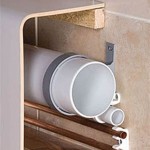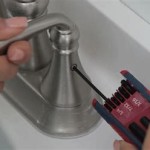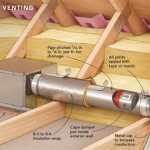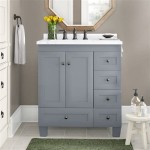How To Clean Bathroom Sink Drain Of Hair
A clogged bathroom sink drain, often caused by accumulated hair, is a common household problem. This obstruction can lead to slow draining, unpleasant odors, and potential plumbing issues if left unaddressed. Effectively removing hair from a bathroom sink drain requires a systematic approach, utilizing a combination of preventative measures and proactive cleaning techniques. Here's a comprehensive guide to tackling this issue.
Preventative Measures to Reduce Hair Accumulation
The most effective strategy for dealing with hair in a bathroom sink drain is prevention. By implementing simple habits and utilizing readily available tools, the accumulation of hair within the drainpipe can be significantly reduced, minimizing the need for frequent and potentially messy cleaning procedures.
One of the simplest preventative measures is the consistent use of a drain strainer or mesh screen. These inexpensive devices are designed to sit directly over the drain opening, acting as a physical barrier that traps hair, soap scum, and other debris before they can enter the drainpipe. Regular cleaning of the strainer is essential for its effectiveness. After each use of the sink, or at least daily, the strainer should be removed and any accumulated debris discarded into a trash receptacle. Avoid flushing the debris down the toilet as this can contribute to plumbing problems in other areas of the house.
Another preventative measure involves being mindful of the type of products used in the sink. Hair products, such as gels, mousses, and hair sprays, often contain ingredients that can contribute to buildup within the drainpipe when washed down the drain. Similarly, certain types of soaps, particularly those with a high fat content, can leave a residue that attracts and traps hair. Whenever possible, try to minimize the amount of these products that go down the drain. Consider using alternative methods for rinsing out hair products, such as using a designated basin or container, rather than directly rinsing them into the sink. Similarly, opting for soaps with less fatty ingredients may reduce the potential for build-up.
Routine flushing of the drain with hot water can also help to prevent the accumulation of hair and other debris. After each use of the sink, allowing hot water to run for a minute or two can help to dislodge any loose hair or soap scum that may be clinging to the sides of the drainpipe. The hot water can also help to dissolve oily residues, preventing them from solidifying and trapping hair. This simple practice can significantly reduce the frequency with which the drain needs to be cleaned more thoroughly. However, it is important to avoid using boiling water, particularly if the drainpipes are made of PVC, as the intense heat can cause warping or damage to the plastic.
Finally, periodic inspections of the drain opening can help to identify potential problems before they escalate. Regularly checking for any visible signs of hair accumulation around the drain opening or within the strainer can provide an early warning that the drain may be becoming clogged. Addressing the situation early, before a significant blockage occurs, can make the cleaning process much easier and less time-consuming.
Methods for Removing Hair from a Bathroom Sink Drain
Despite preventative measures, hair can still accumulate within a bathroom sink drain. Several methods can be employed to remove this hair and clear the blockage. These methods range from simple, non-invasive techniques to more aggressive approaches, depending on the severity of the clog.
The first line of defense is often a simple visual inspection and manual removal of any visible hair. Using a flashlight, carefully examine the drain opening and the area immediately below it. If any hair is visible, attempt to remove it using tweezers or a pair of pliers. Grasp the hair firmly and pull it out slowly and steadily, avoiding any sudden jerking motions that could cause the hair to break off and become further lodged in the drainpipe. Dispose of the removed hair properly in a trash receptacle.
A drain snake, also known as a plumbing snake, is a flexible tool designed to reach deep into drainpipes and dislodge or retrieve obstructions. Several types of drain snakes are available, ranging from simple hand-cranked models to more elaborate power-operated versions. For a bathroom sink drain, a small, flexible drain snake is typically sufficient. To use a drain snake, carefully insert the end of the snake into the drain opening and feed it down the drainpipe, slowly rotating the handle to help it navigate bends and curves. Continue feeding the snake until you encounter resistance, indicating the presence of a clog. Once you've reached the clog, rotate the snake further to break up or snag the obstruction. Then, slowly retract the snake, pulling any dislodged hair or debris with it. Clean the snake thoroughly after each use and dispose of the removed hair properly.
Baking soda and vinegar can be used to create a natural chemical reaction that can help to dissolve hair and other organic matter within the drainpipe. Begin by pouring about one cup of baking soda down the drain, followed by one cup of white vinegar. The mixture will fizz and bubble, creating carbon dioxide gas that helps to dislodge the clog. Allow the mixture to sit in the drain for at least 30 minutes, or preferably overnight, to allow the baking soda and vinegar to fully react and break down the obstruction. After the waiting period, flush the drain with hot water to rinse away any remaining debris. This method is generally safe for most types of drainpipes, but it is important to avoid using it in conjunction with other chemical drain cleaners, as the combination can produce harmful fumes.
A plunger can sometimes be effective in dislodging hair clogs in a bathroom sink drain. Ensure that there is enough water in the sink to cover the cup of the plunger. Position the plunger over the drain opening, creating a tight seal. Push and pull the plunger up and down vigorously for several minutes. The pressure created by the plunging action can help to dislodge the clog and force it down the drainpipe. If the water drains after plunging, run hot water down the drain to flush away any remaining debris. If the clog persists, repeat the plunging process or try another method.
Advanced Techniques and When to Call a Professional
In some cases, simple methods may not be sufficient to clear a stubborn hair clog. For these situations, more advanced techniques may be necessary. However, it is crucial to exercise caution when employing these techniques, as improper use could potentially damage the drainpipes or plumbing fixtures.
The U-bend, also known as the P-trap, is a curved section of drainpipe located under the sink. It is designed to trap debris and prevent sewer gases from entering the house. This bend is a common location for hair clogs to form. Disconnecting the U-bend can allow for direct access to the clog and facilitate its removal. Before disconnecting the U-bend, place a bucket or pan underneath to catch any water or debris that may spill out. Loosen the slip nuts that connect the U-bend to the drainpipes and carefully remove the U-bend. Inspect the inside of the U-bend for any accumulated hair or debris and remove it manually. Rinse the U-bend thoroughly with water before reassembling it. Ensure that the slip nuts are tightened securely to prevent leaks.
Chemical drain cleaners are commercially available products that contain strong chemicals designed to dissolve hair and other organic matter. While these cleaners can be effective in some cases, they should be used with caution. Chemical drain cleaners can be corrosive and can damage drainpipes if used improperly. Always follow the manufacturer's instructions carefully and wear appropriate protective gear, such as gloves and eye protection, when using these products. Avoid mixing different types of chemical drain cleaners, as the combination can produce harmful fumes. Furthermore, repeated use of chemical drain cleaners can weaken drainpipes over time, leading to leaks or other plumbing problems. Therefore, it is generally advisable to use alternative methods whenever possible and to reserve chemical drain cleaners for situations where other methods have failed.
Hydro jetting is a professional plumbing technique that uses high-pressure water to clear drainpipes of stubborn clogs. This method is typically employed by professional plumbers and is not recommended for homeowners to attempt without specialized equipment and training. Hydro jetting can effectively remove hair, grease, and other debris from drainpipes, restoring them to their original flow capacity. However, the high pressure can also damage older or weakened drainpipes, so it is important to consult with a qualified plumber before considering this method.
If all other methods have failed to clear the clog, or if the clog is located deep within the drainpipe and is inaccessible with standard tools, it may be necessary to call a professional plumber. A plumber has the expertise, experience, and specialized equipment to diagnose and resolve complex plumbing problems. They can use tools such as video cameras to inspect the drainpipe and identify the exact location and nature of the clog. They can also use more powerful drain snakes or hydro jetting equipment to clear the clog. In some cases, it may be necessary to replace a section of drainpipe that is severely damaged or clogged beyond repair. Calling a professional plumber can save time, prevent further damage to the plumbing system, and ensure that the clog is resolved safely and effectively.

Top 5 Ways To Get Hair Out Of Your Drains

How To Get Hair Out Of Sink Drain All Coast Inspections

5 Best Ways To Get Hair Out Of Your Drain Stephens Plumbing

How To Clean A Drain Using The Weasel Hair Clog Tool Kit

How To Clean Hair From Drains Properly Moffett Plumbing

Flexisnake Drain Weasel Hair Clog Tool Starter Kit For Cleaning 3 Piece Dwpsk2 The Home Depot

How To Clean Hair Out Of A Drain Nebrasky Plumbing Heating Cooling

Sink Drain Clog Remover Tool 6 Pack Hair Cleaner Shower Snake Removal To For Kitchen Bath Tub Bathroom 20

How To Clear A Clogged Drain Reviews By Wirecutter

3 Easy Ways To Unclog Hair In Your Drain Ricks Plumbing
Related Posts







